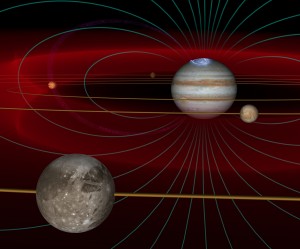Planetary magnetic bubbles
A planet’s magnetic field deflects material flowing from the Sun—the solar wind—around the planet, creating a magnetic sphere of influence: the magnetosphere.
The stronger the magnetic field, the larger its magnetosphere. Earth’s magnetosphere is about ten times the size of the planet. The giant planets of the outer solar system have even stronger magnetic fields whose influence extends far into space, encompassing many of their moons. Seventy thousand suns would fit inside the vast volume of Jupiter’s magnetosphere!
The volcanic moons Io and Enceladus eject up to a ton of gases every second into the surrounding space. These gases become ionized and trapped in the planetary magnetic field. Various processes heat and accelerate these charged particles, further inflating the magnetospheres. Beams of charged particles bombard the planets’ atmospheres, exciting intense auroral emissions spanning x-rays to radio emissions.
By comparing state-of-the-art model calculations with measurements made by particle-detecting instruments that have flown through Jupiter’s and Saturn’s magnetospheres, LASP scientists are probing the mysteries of the magnetospheres of our solar system’s outer planets to better understand the processes that govern these extreme conditions and the consequences for their moons.
LASP scientists:
- Study how the solar wind interacts with the giant magnetospheres of Jupiter and Saturn
- Model how magnetospheric plasma interacts with the volcanic moon Io, spreading tons of neutral and ionized components across the Jovian system
- Simulate Cassini spacecraft observations of water products spewed out in volcanic plumes from Saturn’s moon Enceladus
- Compare optical and ultraviolet emissions from Ihe Io plasma torus with physical chemistry models
- Analyze particle data obtained by Juno to explore processes exciting Jupiter’s auroral emissions

